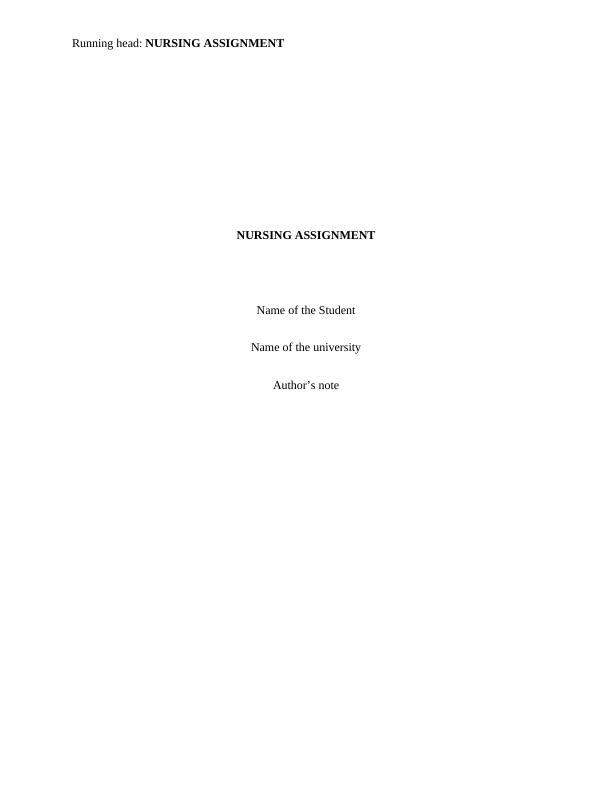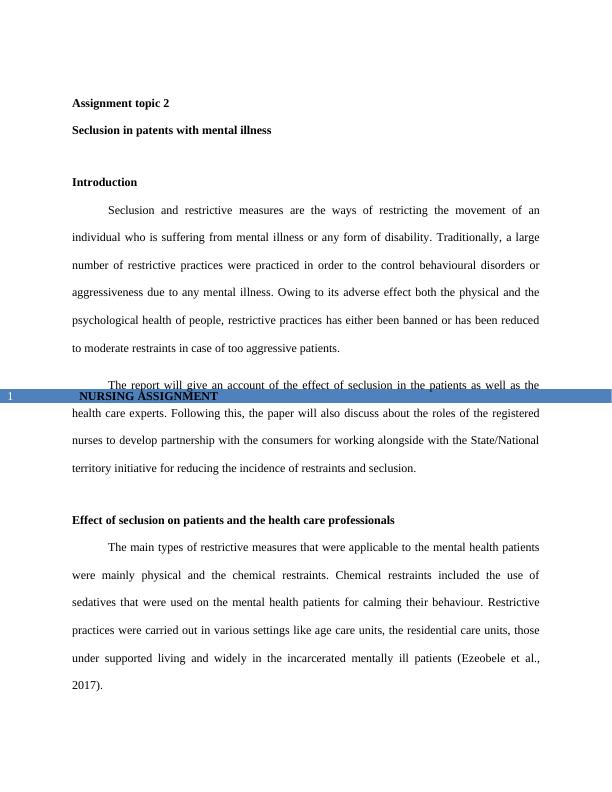Journal of Psychiatric And Mental Health Nursing
9 Pages2562 Words31 Views
Added on 2022-08-29
Journal of Psychiatric And Mental Health Nursing
Added on 2022-08-29
ShareRelated Documents
Running head: NURSING ASSIGNMENT
NURSING ASSIGNMENT
Name of the Student
Name of the university
Author’s note
NURSING ASSIGNMENT
Name of the Student
Name of the university
Author’s note

NURSING ASSIGNMENT1
Assignment topic 2
Seclusion in patents with mental illness
Introduction
Seclusion and restrictive measures are the ways of restricting the movement of an
individual who is suffering from mental illness or any form of disability. Traditionally, a large
number of restrictive practices were practiced in order to the control behavioural disorders or
aggressiveness due to any mental illness. Owing to its adverse effect both the physical and the
psychological health of people, restrictive practices has either been banned or has been reduced
to moderate restraints in case of too aggressive patients.
The report will give an account of the effect of seclusion in the patients as well as the
health care experts. Following this, the paper will also discuss about the roles of the registered
nurses to develop partnership with the consumers for working alongside with the State/National
territory initiative for reducing the incidence of restraints and seclusion.
Effect of seclusion on patients and the health care professionals
The main types of restrictive measures that were applicable to the mental health patients
were mainly physical and the chemical restraints. Chemical restraints included the use of
sedatives that were used on the mental health patients for calming their behaviour. Restrictive
practices were carried out in various settings like age care units, the residential care units, those
under supported living and widely in the incarcerated mentally ill patients (Ezeobele et al.,
2017).
Assignment topic 2
Seclusion in patents with mental illness
Introduction
Seclusion and restrictive measures are the ways of restricting the movement of an
individual who is suffering from mental illness or any form of disability. Traditionally, a large
number of restrictive practices were practiced in order to the control behavioural disorders or
aggressiveness due to any mental illness. Owing to its adverse effect both the physical and the
psychological health of people, restrictive practices has either been banned or has been reduced
to moderate restraints in case of too aggressive patients.
The report will give an account of the effect of seclusion in the patients as well as the
health care experts. Following this, the paper will also discuss about the roles of the registered
nurses to develop partnership with the consumers for working alongside with the State/National
territory initiative for reducing the incidence of restraints and seclusion.
Effect of seclusion on patients and the health care professionals
The main types of restrictive measures that were applicable to the mental health patients
were mainly physical and the chemical restraints. Chemical restraints included the use of
sedatives that were used on the mental health patients for calming their behaviour. Restrictive
practices were carried out in various settings like age care units, the residential care units, those
under supported living and widely in the incarcerated mentally ill patients (Ezeobele et al.,
2017).

NURSING ASSIGNMENT2
One of the restrictive practices is seclusion. Seclusion is confinement of a mental health
patient in a locked room from which he cannot exit on his own (Chieze, Hurst, Kaiser & Sentissi,
2019). This is mainly done when the patient is aggressive and violent and is likely to cause harm
to himself, health care professionals and the other patients present in the ward. According to
Haugom, Ruud and Hynnekleiv, (2019), seclusion raises social as well as an ethical question. In
their work Foucault (1967) and Goffman (1961), they have directly said against the practice of seclusion
to be inhuman, power laden and hierarchical. The basic ethical problem associated to behavior control
involves the law of dilemma of how to advocate the autonomy of a patient in situation where the
suppression can be rationalized with respect to common good of the ward community. In this way the
clinicians often explain or rationalize the restrictive practices. According to Joubert and Bhagwan,
(2018), all individuals have the basic right to be protected from any kind of bodily harm and if seen from
this perspective, the autonomy of an individual should not be negotiated under the protection of the self or
the others. Ideally, the health care professionals can only intervene to seclude the mental health patients,
when they are harming themselves or the others. Riahi, Thomson and Duxbury (2016) on the contrary
have clearly stated that seclusion is against the fundamental rights like the freedom to movement,
physical integrity, dignity and autonomy. A large of evidences have informed about the disadvantages of
coercion and seclusion. Seclusion has been associated with the emotions like fear of confinement
disempowerment, anxiety, depression, shame, anger, stigma, fear of confinement of claustrophobic
atmosphere, feeling of vulnerability, loneliness, loss of autonomy, humiliation and uncertainty
(Ezeobele et al., 2017). Apart from raising an ethical question, it is also an issue or social justice, as the
individual in the patient side is powerless and vulnerable and the right to provide treatment is in the hands
of the health care professionals.
The process of seclusion is against the principle of patient centered care. Patient centered care
can be defined as provision of care that is responsive to the preferences, needs and the values of
One of the restrictive practices is seclusion. Seclusion is confinement of a mental health
patient in a locked room from which he cannot exit on his own (Chieze, Hurst, Kaiser & Sentissi,
2019). This is mainly done when the patient is aggressive and violent and is likely to cause harm
to himself, health care professionals and the other patients present in the ward. According to
Haugom, Ruud and Hynnekleiv, (2019), seclusion raises social as well as an ethical question. In
their work Foucault (1967) and Goffman (1961), they have directly said against the practice of seclusion
to be inhuman, power laden and hierarchical. The basic ethical problem associated to behavior control
involves the law of dilemma of how to advocate the autonomy of a patient in situation where the
suppression can be rationalized with respect to common good of the ward community. In this way the
clinicians often explain or rationalize the restrictive practices. According to Joubert and Bhagwan,
(2018), all individuals have the basic right to be protected from any kind of bodily harm and if seen from
this perspective, the autonomy of an individual should not be negotiated under the protection of the self or
the others. Ideally, the health care professionals can only intervene to seclude the mental health patients,
when they are harming themselves or the others. Riahi, Thomson and Duxbury (2016) on the contrary
have clearly stated that seclusion is against the fundamental rights like the freedom to movement,
physical integrity, dignity and autonomy. A large of evidences have informed about the disadvantages of
coercion and seclusion. Seclusion has been associated with the emotions like fear of confinement
disempowerment, anxiety, depression, shame, anger, stigma, fear of confinement of claustrophobic
atmosphere, feeling of vulnerability, loneliness, loss of autonomy, humiliation and uncertainty
(Ezeobele et al., 2017). Apart from raising an ethical question, it is also an issue or social justice, as the
individual in the patient side is powerless and vulnerable and the right to provide treatment is in the hands
of the health care professionals.
The process of seclusion is against the principle of patient centered care. Patient centered care
can be defined as provision of care that is responsive to the preferences, needs and the values of

End of preview
Want to access all the pages? Upload your documents or become a member.
Related Documents
Australia’s Public Mental Health Systemlg...
|13
|3217
|30
Essay on Mental Health 2022lg...
|12
|3204
|13
Restrictive Practice in Australian Mental Health serviceslg...
|12
|3178
|28
NRSG 263 Mental Health - Restrictive Practiceslg...
|13
|3232
|25
Journal of Korean Academy of Psychiatriclg...
|10
|2698
|14
Restraint Practices in Mental Healthlg...
|11
|3181
|38
